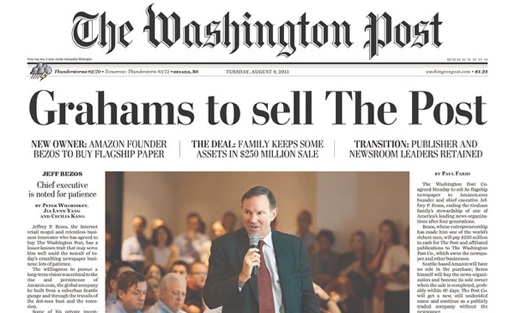The joke going around right now is that nothing will change at the Washington Post, but in two years you’ll only be able to read it on a Kindle.
After seven consecutive years of declining revenue, the Graham family has sold the newspaper to Amazon founder Jeff Bezos. As reported in the Washington Post, Post Company Chairman and Chief Executive Donald E. Graham explained that “The Post could have survived under the company’s ownership and been profitable for the foreseeable future. But we wanted to do more than survive. I’m not saying this guarantees success, but it gives us a much greater chance of success.”
The Graham family bet on Bezos.
The Man from the Other Washington
A changing of the guard is often accompanied by assurances that “nothing will change,” as it has been in this case. Bezos has left Katharine Weymouth in place as publisher and CEO of the Post, and the editorial board and reporters are all still there. It was the only move to make, considering putting a new staff in place overnight is impossible — especially when Bezos doesn’t own a newspaper the size of the Post now.
But in terms of change, these pronouncements are the furthest thing from reality.
The changes in the offing will turn The Post upside down. It won’t even be the Post as we know it. That’s what disruptors like Bezos do — they change things with their ideas and with technology. Just take a stroll down to your neighborhood bookstore, or try to rent a videotape, or buy a vinyl record.
The first break to a new future starts with a new name. The company which owns the Post will be called something else, and it will be private. Bezos is the sole owner of the new organization. Another harbinger of change is that he didn’t buy the Post’s building, which he could have. Headquarters now has no real physical anchor, at least not where it is now. But many organizations don’t need large, expensive physical places to make things work anymore. They are virtual, outsourced spokes with or without a central core.
Whatever else the Washington Post is to Bezos, it is a black box. And what a nice black box to have. His plans have a very large playing field on which to take shape: form, content, power and influence are already in place. There are no boundaries, really. No walls to kick out. As reported in the Post, Bezos typically underplayed his hand. “I don’t want to imply that I have a worked-out plan,” he said. “This will be uncharted terrain, and it will require experimentation.”
I’ve covered Amazon and Bezos since the early days as an analyst for Gartner. Bezos has the money, but he doesn’t have much time. Whatever Bezos does with the Washington Post, including the remote idea of keeping exactly as it is now, it has to become a profit-making entity.
Bezos usually doesn’t reveal his plans. There is no separate reported expense for Research and Development for Amazon, so finding out exactly what financial efforts went into developing any particular piece is not possible.
Putting the Pieces Together
So what can we expect to change within the next five years and why? Here are some reasonable assumptions:
- The editorial policies, the coverage and the content will reflect the interests and ideologies of the owner. For the U.S. government’s hometown newspaper, that’s something to really be aware of.
- The form will be as important as the content, as the Post becomes a digital news organization, delivered on multiple platforms. Printing a physical paper will continue as a loss-leader for a time.
- Content is the prize of the Internet world — getting it, making it profitable, and recycling it for use in other parts of the Internet to reach different audiences in different ways. The Post has it, and access to it, through their organization and reporters.
- Management and operations will change to reflect the delivery of new forms and different content, and will be staffed by people whose allegiance is to the current owner. Bezos doesn’t want to run a daily newspaper, but the people who will manage the editorial policies, decide what to cover, and write the “stories” will be, ideally, trusted and loyal staffers who work for him. Eventually, content will be “sourced” as much as it is now “assigned.”
- Amazon’s e-reader Kindle is already in place as one digital delivery platform. Optimizing content into multimedia, short- and long-form pieces will play a big part in content strategy. Amazon may not be the owner of the Post, but the synergies are clearly there.
- The Post can leapfrog over The New York Times and others in terms of digital news and significantly change the landscape. Being helmed by an Internet magnate has its advantages when it comes to strategic digital success.
Can Bezos fail? Of course. Will he have to sell the newspaper? Maybe. Or worse, he may have to end the Washington Post if it doesn’t show a profit or fulfill other goals.
But at least the Grahams didn’t close down the Washington Post.
Related Coverage
What Could Jeff Bezos Want With the Washington Post? by Dan Pacheco
Poll: Which Tech Billionaire Will Buy a Newspaper Next? by Mark Glaser
Storify: Jeff Bezos Shocks the World, Buys Washington Post by Zach C. Cohen
Janet Asteroff is a writer and analyst in communications and technology. A former Gartner analyst for internet development and enterprise deployment, she covered Amazon and related companies. A consultant and writer for Merrill Lynch, IBM, Citibank and the Conference Board, Janet is a published author and speaker, and holds a doctorate in Communications from Columbia University. She can be reached at www.asteroff.com.



This is literally the stupidest reaction piece I’ve read to date.
This will either the best or the worst that could happen for the future of newspapers.